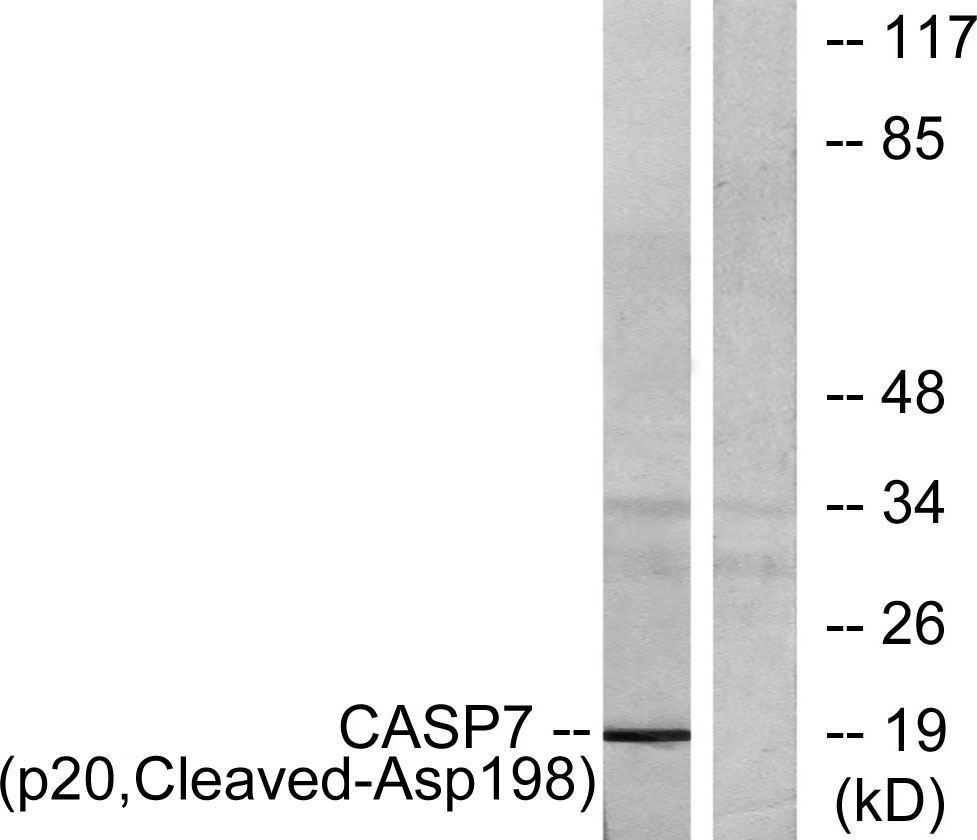Cleaved-Caspase-7 p20 (D198) Cell-Based Colorimetric ELISA Kit
- Catalog No.:KA3923C
- Applications:ELISA
- Reactivity:Human;Mouse
- Gene Name:
- CASP7
- Protein Name:
- Caspase7
- Human Gene Id:
- 840
- Human Swiss Prot No:
- P55210
- Mouse Swiss Prot No:
- P97864
- Storage Stability:
- 2-8°C/6 months
- Other Name:
- Caspase-7 (CASP-7) (EC 3.4.22.60) (Apoptotic protease Mch-3) (CMH-1) (ICE-like apoptotic protease 3) (ICE-LAP3) [Cleaved into: Caspase-7 subunit p20;Caspase-7 subunit p11]
- Detection Method:
- Colorimetric
- Background:
- catalytic activity:Strict requirement for an Asp residue at position P1 and has a preferred cleavage sequence of Asp-Glu-Val-Asp-|-.,enzyme regulation:Inhibited by isatin sulfonamides.,function:Involved in the activation cascade of caspases responsible for apoptosis execution. Cleaves and activates sterol regulatory element binding proteins (SREBPs). Proteolytically cleaves poly(ADP-ribose) polymerase (PARP) at a '216-Asp-|-Gly-217' bond. Overexpression promotes programmed cell death.,PTM:Cleavages by granzyme B or caspase-10 generate the two active subunits. Propeptide domains can also be cleaved efficiently by caspase-3. Active heterodimers between the small subunit of caspase-7 and the large subunit of caspase-3, and vice versa, also occur.,similarity:Belongs to the peptidase C14A family.,subunit:Heterotetramer that consists of two anti-parallel arranged heterodimers, each one formed by a 20 kDa (p20) and a 11 kDa (p11) subunit.,tissue specificity:Highly expressed in lung, skeletal muscle, liver, kidney, spleen and heart, and moderately in testis. No expression in the brain.,
- Function:
- release of cytochrome c from mitochondria, proteolysis, apoptosis, mitochondrion organization, heart development,cell death, apoptotic mitochondrial changes, response to radiation, response to UV, response to light stimulus,response to abiotic stimulus, programmed cell death, death,
- Subcellular Location:
- Cytoplasm.
- Expression:
- Highly expressed in lung, skeletal muscle, liver, kidney, spleen and heart, and moderately in testis. No expression in the brain.
- June 19-2018
- WESTERN IMMUNOBLOTTING PROTOCOL
- June 19-2018
- IMMUNOHISTOCHEMISTRY-PARAFFIN PROTOCOL
- June 19-2018
- IMMUNOFLUORESCENCE PROTOCOL
- September 08-2020
- FLOW-CYTOMEYRT-PROTOCOL
- May 20-2022
- Cell-Based ELISA│解您多样本WB检测之困扰
- July 13-2018
- CELL-BASED-ELISA-PROTOCOL-FOR-ACETYL-PROTEIN
- July 13-2018
- CELL-BASED-ELISA-PROTOCOL-FOR-PHOSPHO-PROTEIN
- July 13-2018
- Antibody-FAQs



